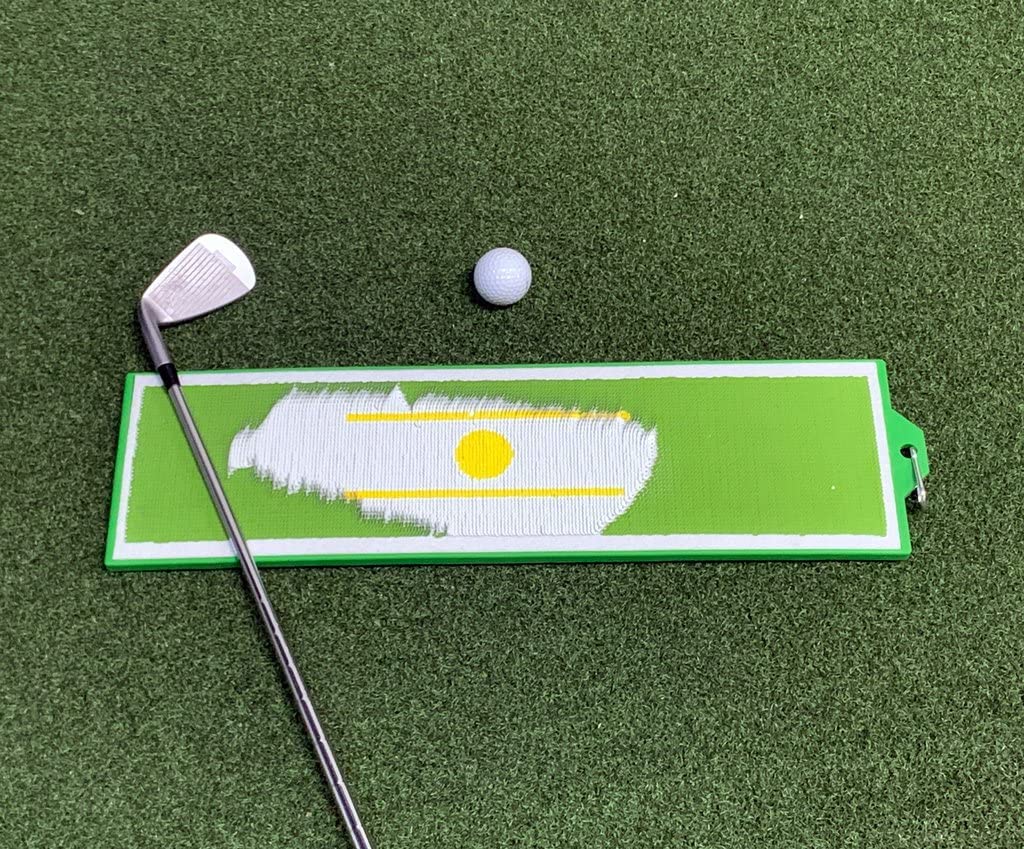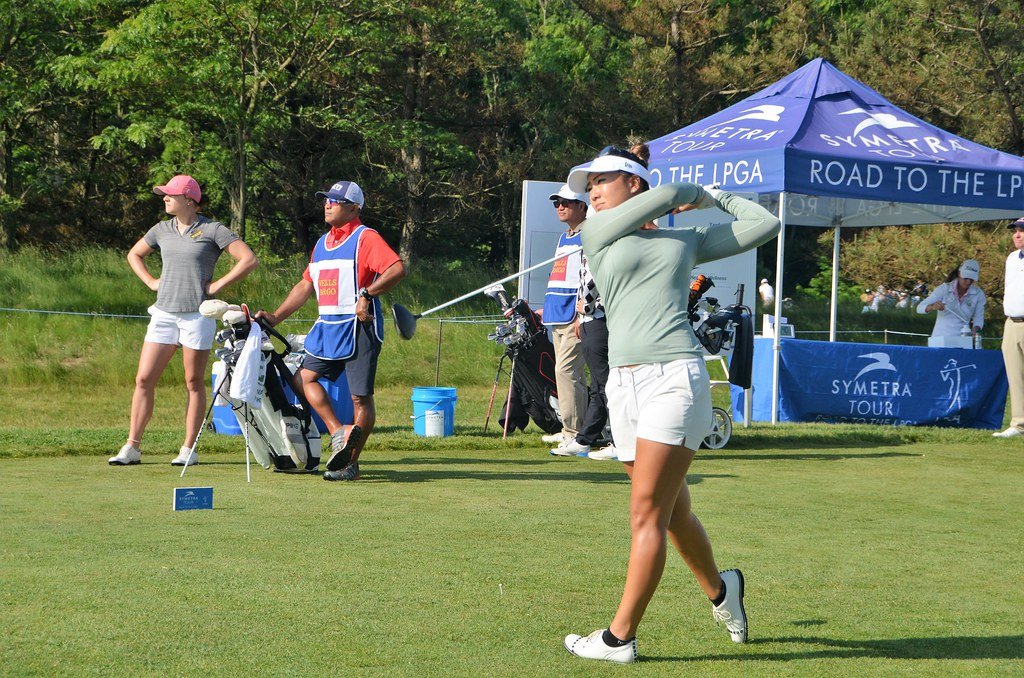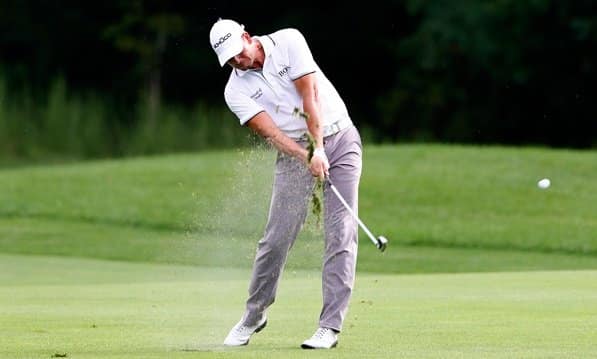One of the biggest concepts amateur golfers struggle with, especially high handicappers, is the need to hit down on the ball with their irons and fairway woods in order to send it up into the air.
Naturally, it’s logical to think that the best way to send the ball flying high into the sky is to try and strike it with an upwards blow.
This works with sports like baseball and hockey, but in golf, swinging up on the ball with an iron in hand can actually spell disaster (driver is a different story though, and you can read more about that here).
Golf is one of few sports where, due to the specifically tailored loft and angle of the clubs, it is vital to strike the ball with a descending blow when playing from the fairway, rough or bunkers in order to send it sky high.
To hit down on the golf ball, it is vital that your swing shallows out after making contact with the ball and has a negative attack angle at the point of contact. This should be achieved by rotating through the shot, rather than letting the lead hip forward slide forward. Focusing on transitioning the weight into the lead leg as you strike the ball will help create this negative attack angle and bottoming out of the swing after collecting the ball.
It may sound simple enough, but hitting down on the ball correctly may take a little more discipline and fine tuning if your are guilty of sliding forward or have an overly steep swing.
As ever, making great contact with the ball starts with a clear understanding of the most efficient way to play a golf shot, as well as the best set up to prepare yourself for success.
If you want to learn more about hitting down on the ball correctly, keep reading.
Table of contents
Is it good to hit down on the golf ball?
Yes, it is good to hit down on the golf ball with most clubs, and wedges and irons should have a negative attack angle when making contact with the ball. However, as you move up into hybrids and fairway woods, you want to feel as if you are ‘sweeping’ the ball off of the ground, more so than coming in steeply and leaving big divots. When playing driver, you should always have a positive attack angle, rather than hitting down.
The amount with which you strike down on the ball is going to be dependent on the club you are using, and as a general rule, the greater the loft on the club, the greater the angle of downward attack can be.
Essentially, increased loft means the club is trying to help you get the ball airborne quite a lot, so there is absolutely no need to swing in an upwards fashion and launch the ball sky high through your own actions.
However, despite the fact hitting downwards is an absolute must with most clubs in golf, simply hacking down on the ball with the wrong technique could actually bring about worse results than if you were ‘sweeping’ the ball or hitting it with a positive attack angle.
How do you hit the golf ball first, then ground?
To hit ball first, then ground, it is important that you reduce backwards sway or movement off of the ball. You should feel that the body turns away from the ball without swaying in the backswing, but then rotates and moves towards your target through contact. As the hips and body rotate, start to load weight into the lead foot to help your club shallow out a few inches in front of the golf ball.
A great drill to try and get some feedback on your strike is to paint a line on the ground with some foot spray, making a few practice swings with a mid-iron with the line central to your stance.
If you find yourself taking a divot on or before the line, or not at all, then you are failing to catch the ball then turf and instead are demonstrating a tendency to produce fat and thin shots.
Once you feel like you have made it so that your swing has bottomed out after the line, add in the golf ball and play a few shots, keeping an eye on those divots.
An even better option than foot spray (so you don’t have to keep reapplying it as you hack up the turf) is a divot board (pictured below).

The design of this board offers great feedback on your swing and divot pattern, leaving a clear mark in the fake turf that indicates fat shots, thin shots, and the direction of the club path.
Here’s the tricky bit: even if you make good moves with your body, poor counteracting movements with the hands can undo all of your good work, especially if it leads to an incredibly steep angle of attack.
Much of this is to do with path and head position, two things that you need to ensure are working with your rotation to shallow the club, rather than being the means of shallowing in itself.
What do I mean by this?
If you try to force a downward strike by leaning forward in the upper body or really chopping down on the ball, you may still get ball first and ground second, but the club will be coming down so steep that it cannons into the turf and leaves a short, deep divot.
This simple explainer from Me and My Golf shows in pictures the exact movements to be wary of here.
In all honesty, their heading of ‘Don’t hit down on your irons’ is a bit click baity, but the point they are trying to make is sound: if you force it, it probably won’t end well.
It is a difficult thing to monitor though as quite often a steep angle of attack will deliver a decent result, so long as you get ball first.
This is usually the case with high-lofted clubs like wedges that tend to be more forgiving, but if you don’t quite catch it 100% perfect, then it’s unlikely a super steep angle of attack will lead to nice, high-flighted shots.
The important things here are head position and club path.
The head needs to move towards target but stay behind the lead hip and shoulder, not lead it by dipping forwards.
As for club path, you need to avoid an over-the-top motion which will cause the clubhead to work down to the ball too steeply.
A great training aid to work on path is the JZ Golf Slice and Hook Corrector that can be set up to train you to come more from the inside.
As on over-the-top action will see you swinging in an out-to-in fashion, by setting up the tool with pegs slanting back towards the body, you’ll be forced to come more from the inside in order to hit the ball.
Should I hit down on my driver?
No, you shouldn’t hit down on your driver. A driver swing should collect the ball with a positive attack angle. However, the answer is a little different for pros, who have an average attack angle that is slightly negative. Despite this, the vast majority of amateur golfers have swing speeds that mean they should hit up, not down, with driver.
While the answer to this question isn’t necessarily a definitive ‘no’ for all, for the vast majority of people an upward strike with driver will yield better results.
However, when you start to move into exceptionally high swing speeds, hitting slightly down on the ball could actually make driver perform better.
The average driver swing speed for PGA Tour players is 113mph, paired with an attack angle of negative 1.3 degrees.
Yes, a downward angle of attack is the norm here, but ask yourself, how often do you crank the clubhead speed up to 113mph?
You and I both know the answer is probably never, hence why comparing yourself to a tour player in this scenario is absurd.
But what about women players?
If we take a look at swing speed data from the LPGA Tour – where women swing driver at an average of 94mph – the comparisons for male amateurs start to become a little more realistic.
If you can generate this sort of clubhead speed – something not out of reach for many weekend golfers – then you may find it interesting to note that they pair this with a positive attack angle of 3 degrees up, on average.
The moral here: the data shows that at clubhead speeds more comparable to amateur golfers, hitting up with driver will lead to better outcomes than hitting down.
The relationship here comes down to two key factors: angle of attack and launch angle, both of which influence dynamic loft.

Dynamic loft, you say? Let me explain.
While your driver might be set at 9 degrees, depending on how you deliver it will have an influence on dynamic loft, the actual loft you present when hitting the ball.
However, the angle with which you present your club – referred to as launch angle – can be somewhat negated by a downward angle of attack.
Different combinations of attack angle and launch angle will lead to differing with dynamic lofts, as well as something called ‘spin loft’ – a crucial concept to understand.
If you have a high launch angle (so you are presenting more loft) but a negative attack angle, you’ll create a lot of dynamic loft, but also spin loft.
What this means is that the ball would roll up the face, generate a lot of spin and potentially travel high but not very far.
The reason why pro golfers are able to swing with a negative attack angle is that they keep launch angle down to a reasonable level, but also swing fast enough that the ball will have plenty of time and energy to travel to a high apex before returning to the ground.
An expensive, but quite possibly worthwhile purchase, is a FlightScope Mevo that will give you all of this data to analyse when at the range.
If you try and swing like a pro does but without the overall power, you’re just signing up for low drives that come to earth early and run out a bit if its dry, but stop dead when it’s wet.
Why do I make a divot with my driver?
If you take a divot with your driver it means you have an attack angle that is way too steep, causing you to send the club down into the ground after making contact with the ball. If you find you make a divot before striking the ball, you likely have too much weight towards the back leg, leading to heavy shots with the driver.
To overcome a steep angle of attack, the two main corrections involve fixing your set up and coming more from the inside.
If you have too much weight forward in your swing or allow the head and lead shoulder to dip when playing driver, its going to send all of your weight forward and cause the driver to ‘bottom out’ after collecting the ball.
While having a shallow point after the ball is good with your irons and wedges, the driver swing requires a shallow point slightly before you make contact with the ball, leading to a positive attack angle.
The best way to determine whether your head and lead shoulder dip forward in your swing is to set up a tripod in a side-on position and film a few shots.
If your head dips down or sways forward, this is something you need to work on.
I’ve always found it tough to do, but sometimes having a buddy hold an alignment stick against your lead cheek to push back against this sway can help you get a sense of how far you are moving.
Focus on correcting your club path
Another possible fix for your driver divots after the ball is correcting an over the top swing.
If your downswing comes outside your original club path, rather than inside of it, then your swing could be rather steep, causing you to hack down on the ball.
One way to try and fix this is by placing a headcover about a foot behind the ball and a little to the outside, with the aim being to make swings where you avoid making contact with the headcover, which should bring your path more from the inside.
The EyeLine Golf Speed Trap 2.0 is a great little training aid that will have a similar effect, but provides a bit more of a challenge.
If you have problems with hitting the ground before the ball when taking driver, it is likely that weight shift is your key issue.
Golfers who sit too far on the back foot throughout the follow through run the risk of bottoming the swing out way too early, causing them to strike the ground prior to the ball.
Weight should transition into the trail foot during the backswing, but needs to shift back into the front foot to help create a shallow point just before the ball with driver, and just after the ball with irons.
A pressure board will give you clear feedback about whether your weight is shifting when it needs to, and if it isn’t, you should spend time working on your transition into your lead leg during the downswing.
Do you take a divot with a fairway wood?
Yes, you should take a small divot with your fairway wood, but many players will still have success with their woods by sweeping them off of the turf. Every club other than driver should have a negative attack angle, so aiming to scuff the ground after the ball at the very least should see your fairway woods perform quite well.
Where you place the ball in your stance is an important factor to consider when approaching a fairway wood shot from the ground, as sweepers and people who hit down need to set up slightly differently.
If you hit down on your fairway woods and take a divot or scuff the ground, a position about a ball or even a ball-and-a-half in front of centre is going to help you collect the ball while your club is still on a downward trajectory.
However, if you more so sweep the ball off the ground, then this set up could cause you to feel like you must lean back off the ball so that you don’t come in too steep.
If you don’t take a divot with your fairway wood, then you really should be set up with the ball about two inches in front of centre in your stance so that you collect the ball with a fairly neutral angle of attack.
Why am I hitting down on the golf ball too much?
If you hit down on the golf ball too much then it is probably due to one of two reasons: you have too much weight pressing forward, or you have an over-the-top swing. If your upper body tilts too much towards your target, or you have too much weight through the front foot, it will promote an overly steep swing and deep divots.
An over the top swing can also lead to you taking deep craters in the ground and hitting shots that come off OK at times, but are horrendous at others.
If you drive too much weight into your front foot during the golf swing then you may be able to take ball before ground, but the angle of attack is so steep that the club will drive deep into the ground.
It will almost feel like the club gets stuck, and that it’s hard to make a good follow through.
You may play some OK shots like this, but your ball flight is probably going to be quite low due to a delofted club.
Believing that the best way to hit down on the ball is by tilting the upper body over the ball will lead to a fairly similar result.
The trickier bad habit to identify is the issue of coming over-the-top, as you could have great weight distribution and stay nicely upright in the swing, yet still hack down on the ball.
A shallow, inside swing path helps to keep divots to a productive depth, so if you really drive the club down into the earth then it could be due to an over-the-top swing.
Set your phone up on a tripod and film a few things to identify whether you cast the club out and over the line with which you took it back on (read our article on how to record your swing correctly here).
If this is the case, then working on shallowing the club at the top of your swing and coming more from the inside is a must to reduce your attack angle to something a little less severe, while still keeping it in the negatives.
Final message
Most weekend players fail to hit down on the ball enough, and by failing to do so leave countless yards in the bag given they don’t compress the golf ball.
Sweeping the ball off the turf may be seen as a way to avoid too many fat and thin shots by some, but if you really want to strike the ball well and play to a higher level, learning how to hit down on the ball properly is a must for any dedicated golfer.


